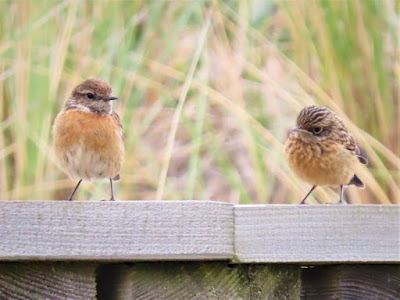Gronant
Some confusion over the paths needed to access the viewing platform saw me headed for Point of Ness by mistake. Carrying the necessary telescope made photography more difficult. Amongst many fleeting view Sedge and Reed Warblers was this more cooperative male Reed Bunting.
There was some very interesting vegetation with the highlight this Pyramidal Orchid (Anacamptis pyramidalis).
So the terns could only be seen in flight and at some distance. Thus all these images are necessarily significantly cropped and enlarged. So I apologise for the poor quality of some of them. One passing. These birds have a black-tipped yellow bills and a white forehead.
This one carrying a small fish, likely a sand-eel.
They always seem to hold the fish in the tip of their bill.
Looks like this one is struggling to hold on to its fish.
Perhaps the closest fly-by. The white forehead is obvious here.
A plan view of one passing over.
One hovering.
A trio passes by. These are very vocal birds and the closest have their bills open, calling.
A family of Stonechats provided a welcome bonus. A female on the left and a juvenile on the right.
Juvenile wants feeding but mums seems unimpressed.
"FEED ME!!!!" Meanwhile mum bounces off.
Juvenile seems none too happy.
Here is mum again.
And juvenile again.
And a male from a different family
Then on to Conwy where this Great Egret was on show. When seen like this the long neck and long yellow bill make any confusion with the black-billed Little Egret unlikely. On its left leg the top of a ring is just visible ...
'White AAT on red'. The RSPB staff on duty knew about the ring but could not provide any information as to its origin.
This illustrates the difference nicely – four Little Egrets with black bills; two Great Egrets with yellow bills and a Grey Heron for size comparison.
The least expected sighting here at this date was a pair of (Eurasian) Wigeon. They do breed in small numbers in Northern England and Scotland but most will be in Northern Europe at this date. The drake was rather too distant to photograph but this duck was closer. At this time of year when ducks are moulting identification is not always straightforward. The clues here are the rufous tones in the flanks and the dark around the eye – a Dusty Springfield fan, clearly (if you old enough to remember).






















